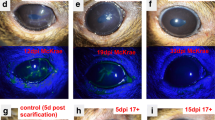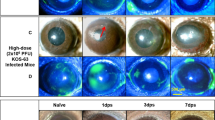Abstract
Purpose
Trigeminal and other ganglia are known as sites of latent infection by herpes simplex virus type 1 (HSV-1). In ophthalmology, HSV-1 remains latent in the trigeminal ganglia, and becomes reactivated by several factors, including stress, thermal stimulation, or immunosuppression, and may lead to herpetic keratitis. The purpose of this study was to demonstrate HSV corneal latent infection using molecular biology and virology techniques.
Methods
Six corneas obtained at penetrating keratoplasty were snap-frozen; three of them were with past history of herpetic keratitis. TaqMan Real-time PCR was used to show positive HSV DNA in the corneas. We proved negative homogenate and positive explant virologically. Using real-time RT-PCR, we showed that only latency-associated transcript (LAT) was detected and no transcriptional products of other virus genes (α, β, γ) were detected.
Results
All three corneas with past history of herpetic keratitis had HSV DNA and showed negative homogenate and positive explant. LAT was detected in all three corneas. However, α, β, or γ genes were not expressed. All the results of these corneas were consistent with the conditions of corneal latency. The other three corneas without history of herpetic keratitis showed negative homogenate and negative explant. None of them had LAT.
Conclusion
We have shown a possibility that HSV can latently infect the cornea aside from the ganglion.
Similar content being viewed by others
References
Stevens JG. Human herpesvirus: a consideration of the latent state. Microbiol Rev. 1989;53:318–32.
Sawtell NM, Thompson RL. Rapid in vivo reactivation of herpes simplex virus in latently infected murine ganglionic neurons after transient hyperthermia. J Virol. 1992;66:2150–6.
Haruta Y, Rootman DS, Hill JM. Recurrent HSV-1 corneal lesions in rabbits induced by cyclophosphamide and dexamethasone. Invest Ophthalmol Vis Sci. 1989;30:371–6.
Richter ER, Dias JK, Gilbert JE, et al. Distribution of herpes simplex virus type 1 and varicella zoster virus in ganglia of the human head and neck. J Infect Dis. 2009;200:1901–6.
Yamamoto Y, Hill JM. HSV-1 recovery from ocular tissues after viral inoculation into the superior cervical ganglion. Invest Ophthalmol Vis Sci. 1986;27:1447–52.
Shimomura Y, Mori Y, Inoue Y, Kiritooshi A, Ohashi Y, Manabe R. Herpes simplex virus latency in human cornea. Jpn J Ophthalmol. 1993;37:318–24.
Kaye SB, Lynas C, Patterson A, Risk JM, McCarthy K, Hart CA. Evidence for herpes simplex viral latency in the human cornea. Br J Ophthalmol. 1991;75:195–200.
Openshaw H, McNeill JI, Lin XH, Niland J, Cantin EM. Herpes simplex virus DNA in normal corneas: persistence without viral shedding from ganglia. J Med Virol. 1995;46:75–80.
Morris DJ, Cleator GM, Klapper PE, Cooper RJ, Biney EO, Dennett C, et al. Detection of herpes simplex virus DNA in donor cornea culture medium by polymerase chain reaction. Br J Ophthalmol. 1996;80:654–7.
Kaye SB, Baker K, Bonshek R, Maseruka H, Grinfeld E, Tullo A, et al. Human herpesviruses in the cornea. Br J Ophthalmol. 2000;84:563–71.
Fukuda M, Deai T, Higaki S, Hayashi K, Shimomura Y. Presence of a large amount of herpes simplex virus genome in tear fluid of herpetic stromal keratitis and persistent epithelial defect patients. Semin Ophthalmol. 2008;23:217–20.
Gordon YJ, Romanowski E, Araullo-Cruz T, McKnight JL. HSV-1 corneal latency. Invest Ophthalmol Vis Sci. 1991;32:663–5.
Kennedy DP, Clement C, Arceneaux RL, Bhattacharjee PS, Huq TS, Hill JM. Ocular herpes simplex virus type 1: is the cornea a reservoir for viral latency or a fast pit stop? Cornea. 2011;30:251–9.
Stevens JG, Wagner EK, Devi-Rao GB, Cook ML, Feldman LT. RNA complementary to a herpesvirus alpha gene mRNA is prominent in latently infected neurons. Science. 1987;27(235):1056–9.
Kent JR, Kang W, Miller CG, Fraser NW. Herpes simplex virus latency-associated transcript gene function. J Neurovirol. 2003;9:285–90.
Bertke AS, Patel A, Imai Y, Apakupakul K, Margolis TP, Krause PR. Latency-associated transcript (LAT) exon 1 controls herpes simplex virus species-specific phenotypes: reactivation in the guinea pig genital model and neuron subtype-specific latent expression of LAT. J Virol. 2009;83:10007–15.
Shimomura Y, Higaki S. The kinetics of herpes virus on the ocular surface and suppression of its reactivation. Cornea. 2011;30(Suppl 1):S3–7.
Higaki S, Watanabe K, Itahashi M, Shimomura Y. Cyclooxygenase (COX)-inhibiting drug reduces HSV-1 reactivation in the mouse eye model. Curr Eye Res. 2009;34:171–6.
Kaufman HE, Azcuy AM, Varnell ED, Sloop GD, Thompson HW, Hill JM. HSV-1 DNA in tears and saliva of normal adults. Invest Ophthalmol Vis Sci. 2005;46:241–7.
Sawtell NM, Thompson RL, Stanberry LR, Bernstein DI. Early intervention with high-dose acyclovir treatment during primary herpes simplex virus infection reduces latency and subsequent reactivation in the nervous system in vivo. J Infect Dis. 2001;184:964–71.
Luppi M, Barozzi P, Morris C, Maiorana A, Garber R, Bonacorsi G, et al. Human herpesvirus 6 latently infects early bone marrow progenitors in vivo. J Virol. 1999;73:754–9.
Frenkel N, Schirmer EC, Wyatt LS, Katsafanas G, Roffman E, Danovich RM, et al. Isolation of a new herpesvirus from human CD4 + T cells. Proc Natl Acad Sci USA. 1990;87:748–52.
Acknowledgements
This study was supported by the Michiko Kihara Ophthalmic Medical Fund of the Osaka Community Foundation. The authors wish to thank Mrs. Yukiko Mimuro for the editing of this manuscript and Mrs. Mayumi Mizuno for her technical assistance.
Conflicts of interest
S. Higaki, None; M. Fukuda, None; Y. Shimomura, None.
Author information
Authors and Affiliations
Corresponding author
About this article
Cite this article
Higaki, S., Fukuda, M. & Shimomura, Y. Virological and molecular biological evidence supporting herpes simplex virus type 1 corneal latency. Jpn J Ophthalmol 59, 131–134 (2015). https://doi.org/10.1007/s10384-014-0369-6
Received:
Accepted:
Published:
Issue Date:
DOI: https://doi.org/10.1007/s10384-014-0369-6




